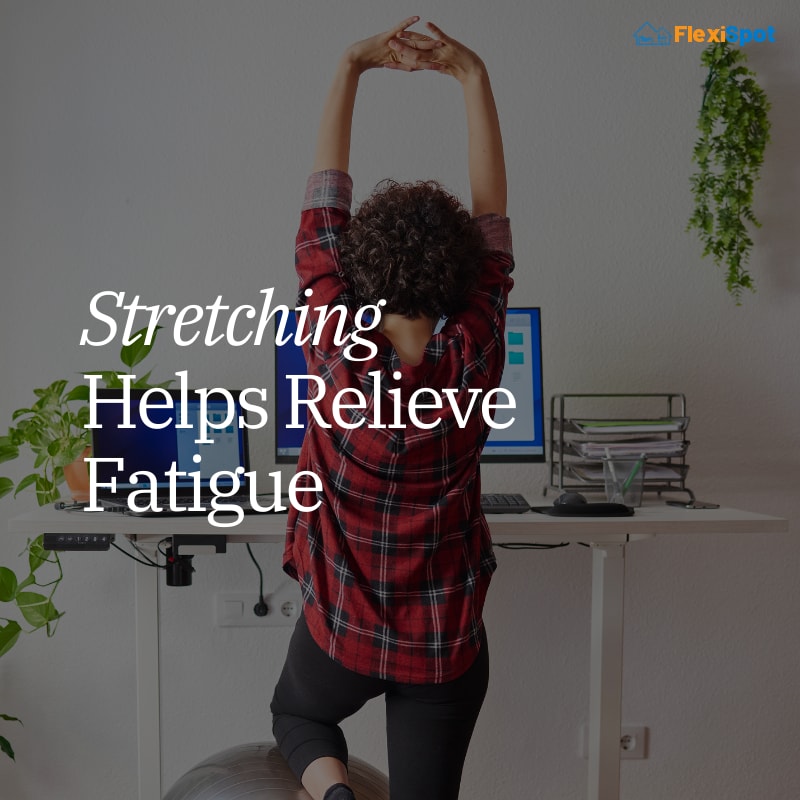Every one of us carries stress in our bodies. When you are under a lot of stress, your muscles constrict, making you feel tense and on edge. Stretching generates natural endorphins, which help you relax, improve your mood, and lower your stress levels. Stretching at the office gives your muscles plenty of time to relax and loosen up. Stretching promotes blood flow to the muscles transports oxygen and a variety of essential nutrients, reducing bodily discomfort.
The best reason to stretch first thing in the morning is to increase vitality. A few excellent stretches, done correctly with deep breathing, can provide you with the boost of energy you need to get your day started. If you're starting to feel tired at work, take a little "stretch break" to re-energize yourself.
Stretching every day at your workplace bright and early can significantly decrease the risk of injury and promotes a healthy, safe, and cohesive culture. It is crucial to warm up and stretch your body, whether it is on your own time or at work.
Companies and their employees can benefit from an effective stretching program that includes stretching and warm-up exercises to help prevent musculoskeletal disorders, reduce fatigue, and improve overall productivity. However, it is important to properly develop and execute the pre-shift stretching program to take advantage of all of the benefits and improve overall health and safety.
Sprains, strains, fatigue, and a variety of other musculoskeletal ailments can all be avoided with the right program. Although sprains and strains may not appear to be serious, safety managers who are on top of their game know that soft tissue injuries account for the majority of fatigue and workplace injuries.

Are Workplace Stretching Programs Effective?
After a long day at work, whether in an office or outdoors, your muscles can get weary, stiff, and sore. The effects of daily wear and tear, as well as back, neck, and shoulder pain can significantly affect productivity and job satisfaction.
One of the best ways to overcome office fatigue and stress is by taking regular stretching breaks throughout the day. A workplace stretching program is a quick strategy to avoid discomfort and stiffness from a long day at work. Fortunately, there are many ways to stretch, and it doesn’t have to be too tiresome either. One such way is by using a high-quality, adjustable standing desk.
With Seiffen Laminated Spliced L-Shaped Standing Desk, you have the flexibility to adjust the height of the desk according to your comfort. You can also work while standing up to change your posture and straighten out your back.
Stretching is a useful habit to add to your everyday office routine. It can help you avoid soft tissue injuries, increase your vitality, possibly improve your range of motion, and reduce fatigue while working. Companies may perform an ergonomic evaluation, hold a training session, or implement pre-shift stretching. These are all important things to do, but most workers don’t have time, especially when you have your head wrapped around a tight deadline or an important project.
Nonetheless, the benefits of workplace stretching should not be overlooked. Ergonomic factors and conditions, such as an adjustable standing desk, can help employees stretch at their station without disrupting their work and consequently reduce levels of fatigue.
When it comes to reducing office fatigue, you don't have to adopt one or two methods on the spur of the moment and hope for the best. Rather, you'll need a comprehensive, well-thought-out preventative strategy that focuses on long-term health and safety benefits.
Preventing work fatigue is as simple as proactively implementing a complete strategy that eliminates all causal risk factors. This will help organizations prevent fatigue in a regular and predictable manner.

Ergonomics in the Workplace – Reducing Fatigue While Working
Ergonomics is the science of building a workplace that accommodates the limitations and strengths of different teams. The purpose is to ensure that the work is appropriate for the worker, lowering the risk of harm and enhancing safety, productivity, and quality of work. Workplace risk factors are identified and controlled through the ergonomics approach. Stretching and warm-up activities complement the ergonomics procedure.
Stretching every day can aid posture by extending muscles that tend to stiffen when we sit in a chair for long periods of time at work. Maintaining good spine alignment requires focusing on your lower back, chest, and shoulders. Stretching can also help with aches and pains that make you want to slouch.
The first thing you need to do to practice ergonomics at your workplace in order to reduce office fatigue is to correct your posture. Your shoulders should be back, and your head should be up. To enhance blood circulation, don't lock your knees, just bend them slightly.

Stretching Helps Relieve Fatigue
As the hours tick away, you’re hunched over your desk, typing away while your back is killing you and your shoulders are strained. We have all been there. But perhaps now it is time to combat the issue and overcome the challenges of office fatigue. If you’re in the same boat, you’ve probably considered getting a standing desk at work.
Various studies have suggested that people are stimulated by movement. They will have more energy for the next two hours if they stand at work or take a break from sitting to go for a 10-minute brisk walk.
Stretching is an important aspect of any exercise routine. By lowering fatigue, improving muscular balance and posture, and enhancing muscle coordination, pre-shift stretching and warm-up activities reduce the incidence of musculoskeletal injuries. Tightness and resistance in tendons and muscles are reduced by regular stretching or warm-ups.
Stretching also reduces office fatigue by improving the blood flow and nutrient delivery to the joints and soft tissues. It raises the temperature of soft tissues and improves tissue flexibility. Furthermore, stretching also improves joint synovial fluid (the lubricant that keeps bones and articular cartilage in place), allowing a higher range of motion and reducing joint deterioration. This enables the joints to move through a wider range of motion while using less energy.
Stretching boosts blood flow to painful muscles while also relieving weariness. Stretching helps to maintain oxygen flowing to your muscles, which keeps muscle weariness at bay. As a result, your muscles will be able to "hang in there" for a longer period of time before becoming fatigued!

Ergonomics of Standing Desks: Get the Right Position
The term ergonomics is typically associated with office computer equipment and furniture. Ergonomics relates to how equipment is designed to fit the shape of the human body comfortably. The manufacturers of office equipment and furniture have come up with some pioneering ways to assist you to have better posture while you work, using biotechnology and design engineering.
Standing desks have become increasingly popular in recent years. According to a recent study, the use of standing desks as an employer-provided office perk increased by 7% in the previous year. Having standing desks at the workplace is part of the ergonomic exercise and has a significant positive impact on employee morale.
Standing desks used to be made up of a stack of books or a few crates stacked up under your laptop. A standing desk may now be customized with various levers for raising and adjusting the keyboard, keeping the computer at eye level (to avoid neck strain and hunching over), and even a comfy wrist pad for your mouse.
You will, of course, not have to perform every task while standing. Taking a call, video conferencing, or sending a fast email, for example, are all simple standing operations. Writing, designing, and conducting thorough research, on the other hand, may be easier to complete while seated. Therefore, you must allow yourself enough time to get into a sitting and standing habit. Aim for a couple of 15-30 minute standing intervals throughout the day until you find a comfortable equilibrium.
Measures to prevent knee and leg strain are another part of standing desk ergonomics to consider. Standing for lengthy periods of time with your knees locked or in heels can put a strain on your legs and lower back. Maintain a small bend in your knees. Look for a comfy standing mat that's designed to go with your desk, and stand in comfortable, supportive shoes. This healthy practice will not only improve posture and productivity but will also reduce office fatigue that we all experience at the end of the day. Standing at work has never been easier, thanks to these ergonomic standing workstations.
Final Thoughts
So, are workplace stretching programs effective? The answer is, yes, they are! One of the primary objectives of a stretching routine is to increase blood flow to the extremities and reduce fatigue. Blood transports oxygen to your cells and improves your general health. This helps your organs operate properly by promoting cell growth and reducing stress.
Stretching also decreases your heart rate, reducing the strain on your heart and allowing your blood pressure to stabilize. Stretching can also help to minimize fatigue, stress, and discomfort by improving blood circulation. Furthermore, as you grow more flexible, your body uses less energy to do daily tasks; thereby reducing office fatigue.

